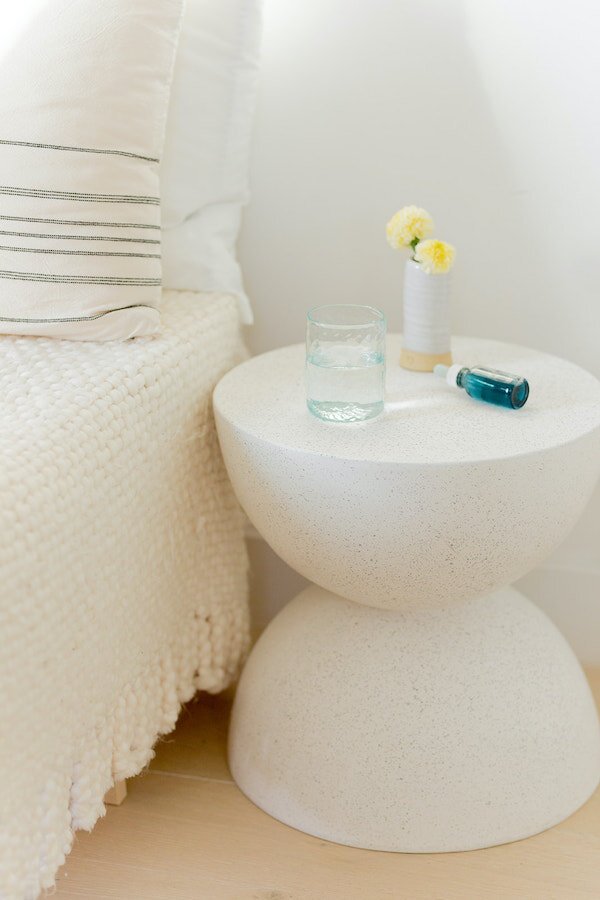
Can A Bedtime Routine Help You Get Better Sleep?
How To Actually Get Ready For Bed
I’ve scoured the internet for sleep advice, and it always boils down to a list: no caffeine, no meals, no exercise, no work, and most importantly, no screens before bed. I get it.
But I’m also human, so of course I’m eating macaroni at 9PM while indulging in videos of people building houses in The Sims. In fact, part of my current nightly routine includes watching vloggers while I wash my face and floss my teeth. It makes me happy and slows down my racing thoughts, even though the sleep-internet will probably call it a “bad habit.” Does this mean I’m setting myself up for failure?
The screen-free advice isn’t just there to help us avoid doomscrolling. There’s a biological reason we should lean into the darkness of the evenings: our circadian rhythms, which cycle on a 24-hour basis, are deeply connected to daylight hours. “Our circadian rhythms are our biological clocks. They never stop working for us, but many times, often without realizing it, we get in the way of these natural rhythms,” explains Emily Galvin, CMPC, MS. “When we honor them by monitoring the timing of our activities in the day and at night, we enhance our opportunities for more routinely restful sleep.”
Galvin, who recommends a bedtime routine, also adds that what we do during the day can support an easier transition into sleep. Getting exposure to natural light, moving our bodies, limiting caffeine—all during daylight hours can help support a healthy circadian rhythm. (So if you’re looking to implement a bedtime routine, consider your afternoon walk a part of that!)
Routines in general help with stress and anxiety, especially during extreme disruption, like a pandemic. And when you’re less stressed, surveys have revealed that you’re prone to longer, better sleep. (And when you’re well-rested? You feel less stressed! It’s a cycle.)
“Caring for myself as if I were a child is helpful: following my instincts, allowing room for play, and tucking myself in at reasonable hours.”
Bedtime routines, especially, have been shown to help support better sleep for children and improve maternal moods. I’d argue that all adults are just larger children (see my routine above, occasional macaroni and all), and I often find that caring for myself as if I were a child is helpful: following my instincts, allowing room for play, and tucking myself in at reasonable hours.
No matter what the “perfect sleep routine” videos on YouTube might tell you, there’s actually no one way to build bedtime habits.
What’s important is having a routine in the first place. There’s no shame in finding what works for you, even if a little pasta before bed makes the perfect tuck-in. We’re not building a press-friendly routine for our hypothetical Forbes “day-in-the-life” interview, and we don’t have to aim for a 4AM wakeup. Instead, we just need a plan for when that little “get ready for bed” notification pops up on our phone.
“Take at least 30 minutes to wind down, doing things that calm your body and soothe racing thoughts.”
“Good sleep doesn’t just happen,” says Dr. Neil Stanley, author, sleep expert and Director of Sleep Research. “To achieve good sleep, you need to quiet your mind and relax your body.”
Stanley recommends taking at least 30 minutes to wind down, doing things that calm your body and soothe racing thoughts. This will signal to the body that it is time for rest and will allow you to put the stresses and worries of the day behind you. (Specifically: “Don’t work, don’t argue with your partner, don’t open the gas bill.”)
What should those 30 minutes look like? Well, it’s really up to you.
30 Minutes Before Bed: Be Intentional About Your Screens
These days, I think of my bedtime routine like my morning routine—as a space for me to exist, without judgment, while I transition from one part of the day into the next. Which, yes, means that sometimes there are screens involved. There’s often so much focus on being “screen-free” that we forget stress and anxiety are also common causes of insomnia. Instead of shame-spiraling about being on our phones, I much prefer approaching alleviation for stressors instead.
A perfectly analog nighttime routine would be lovely (wouldn’t it?), but it’s not always fathomable for any number of reasons. If screen-time seems unavoidable, I try to swap some of my daytime tasks to right before bed, like gentle cleaning. Loading or emptying the dishwasher, taking out the recycling, or packing lunch for the next day all support a better tomorrow and also keep my hands busy and phone-free.
“If a habit calms you, you’re on the right track.”
Other times, I put my screen to good use: I like taking a few guided moments of calming breath (here’s 30 seconds!). Maybe you like to listen to storytelling podcasts or find that ASMR clears your mind (here’s a YouTube channel I particularly love for calming ambient soundtracks). You can even create a special playlist for bedtime, that will help ease your mind into sleep mode.
If a habit calms you, you’re on the right track. Maybe you spend the last bit of your day reading, or perhaps you take a few moments to play your favorite meandering and mindful video game. (I love doing that after a particularly intense day; just be sure to set a timer, so you don’t end up playing late into the night!)
Other traditional screen-free ways to wind down each day include journaling, drinking tea, and meditation—but if these activate your mind or don’t fit into your schedule, don’t fret.
10 Minutes Before Bed: Give Yourself Turn Down Service
These last few minutes before I get into bed feel most crucial to be off of screens. Each night, I “tuck” my phone into its hallway charging station after triple-checking my alarm. I turn off the lights as I say goodnight to each room in my home. I then like to do one small thing to make my bedroom cozy for sleep.
Here are some of my favorite simple strategies that still feel luxurious, especially after a day where you may not have had any time to pamper yourself.
-
Select one small table or corner to tidy—even if it’s hanging up that shirt you decided not to wear this morning
-
Refill your humidifier or empty your dehumidifier
-
Flip and fluff your pillow, or change your pillowcase if it’s been a minute
-
Diffuse your favorite bedtime essential oil or mix a couple drops with water and spritz it on your mattress (scent is strongly attached to memory, so pick one scent that relaxes you and stick with it)
-
Savor the final drops of your tea or a glass of water
-
As you put yourself to bed, mentally “put to bed” the things on your to-do list, your worries, your regrets (putting them on paper can feel therapeutic)
When You’re In Bed: Clear Your Mind, Relax Your Body
Maybe you’ve perfected your routine, or maybe the last 30 minutes didn’t go according to plan—but you’ve finally arrived in your bed. How do you fall asleep?
I’ve unknowingly created an in-bed ritual that helps me fall asleep that starts with me laying on my right side, then my left, then back to my right side where I doze off. Something about these motions helps signal my brain and my body that the day is done. Think about what small physical movements make you feel safe. Perhaps it’s tucking your arms under your body, curling into a fetal position, or spreading out like a starfish. Consider these movements as part of your routine, because they are.
Turn on any white noise you might need, pull your sleep mask over your eyes (I highly recommend), and take some calm, easy breaths. Your day is done, and what will come tomorrow will come.
“Your bedtime routine should feel compassionate, not forceful.”
Your bedtime routine should feel compassionate, not forceful, and even if you only have five minutes between tucking the kids in and climbing into bed, you can still add in grounding moments. “Think guidance, not law,” reminds Dr. Stanley. “Sleep is a very individual thing and so the sleep hygiene ‘rules’ should be seen merely as guidance that needs personal adaptation—listen to your own body.”
The goal is to soothe and calm yourself in the best ways you have available. If you’re not sure whether you’re getting good sleep, or if you want to see which habits are working, consider keeping a sleep log or perhaps even a dream log.
Do you have a bedtime routine? What does it look like? Share in the comments below, because we could all use some ideas!
RELATED READING
Emily Torres is the Managing Editor at The Good Trade. She’s a Los Angeles transplant who was born and raised in Indiana, where she studied Creative Writing and Business at Indiana University. You can usually find her reading or writing, caring for her rabbits, or practicing at the yoga studio. Say hi on Instagram!

